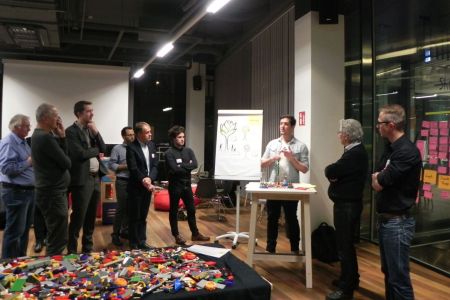

Solar thermal goes digital
 On 14 December 2017, members of industry associations Austria Solar and BSW-Solar met founders of start-ups to draw up digital strategies for solar thermal. One of the key findings from the one-day workshop in Vienna, Austria, was that “traditional solar thermal companies cannot take on this task alone. They will have to partner with start-ups to explore and utilise the potential that digitalisation has for their business,” Roger Hackstock, Managing Director of Austria Solar, said.
On 14 December 2017, members of industry associations Austria Solar and BSW-Solar met founders of start-ups to draw up digital strategies for solar thermal. One of the key findings from the one-day workshop in Vienna, Austria, was that “traditional solar thermal companies cannot take on this task alone. They will have to partner with start-ups to explore and utilise the potential that digitalisation has for their business,” Roger Hackstock, Managing Director of Austria Solar, said.Photo: Austria Solar
Altogether about 35 people participated in the workshop at the weXelerate business incubator in Vienna. The meeting had been organised jointly by industry organisations Austria Solar and BSW-Solar and was held in preparation for a trip to Silicon Valley, California, this June.
“Alexa, is my roof suitable for solar thermal?”
The participants took notice of the many opportunities which digital strategies have to offer along the solar thermal value chain. What can be very helpful at first contact is a chat bot. One company that develops chatbot solutions for customer service, marketing and sales is Austrian start-up Onlim, whose clients come from the energy and tourism sectors. Many of the questions which customers have during an initial conversation are very similar – they want to know about equipment costs, energy savings and a system’s suitability for a given roof.
On the other hand, the solar business needs to know the roof size and orientation and the main type of fuel used for heating. “This conversation can be automated to quite a great extent,” Hackstock explained. The programmed responses can not only be implemented on company websites, but also be incorporated into digital assistants, such as Siri and Alexa. “After answering initial questions, the bot can find a local installation partner where the customer can get further assistance,” the managing director said. “The concept is similar to the frequently asked questions section on most other websites – but it reaches more people and does so in a more modern way.”
Customer-centric view on maintenance and visualisation
The workshop also turned the spotlight on existing digital solutions for solar thermal. Nearly all solar system providers have visualisation software for their systems. But so far, most of these applications have provided only figures and charts. “Many apps require the customer to draw their own conclusions,” Hackstock said. To elicit a more emotional response to solar heating, the outcomes should be presented in a simple and customer-focused manner. For example: “This month, the gas boiler was only needed on two days.” Or: “You saved EUR 300 on your gas bill.”
Monitoring shows room for improvement too. Rather than merely sending data to an installer, a system equipped with modern communications technology and state-of-the-art algorithms could perform most of the monitoring on its own – and send a message to the installation business if something needs to be repaired on site, for example, if the pressure or temperature in the circuit drops below a certain threshold.
Teaming up with data specialists
The difference in points of view between solar thermal companies and start-ups will quickly become evident when a decision needs to be made about the relevancy of information gathered by the system. Most solar businesses will focus on data such as roof space and orientation to assess technical feasibility. By contrast, start-ups will make the cost of fuel and energy generation a priority in order to evaluate whether a business model is working.
The more data is available on site, the more information can be used to optimise the heating system. For example, if the weather forecast predicts a sunny day, a backup boiler may not be started at all. In a hotel, the occupancy rate can be factored in to calculate the amount of hot water that will be needed on a given date.
Gathering all this data does not have to be done by the solar or heating company. Energomonitor from the Czech Republic has specialised in measuring energy-relevant information at customers’ homes, be it gas or water demand or the power consumption of all or of only individual appliances. The strategy of Energomonitor is “what gets measured gets managed”, as Business Development Manager Aron Lazarchick put it. The data can be used by smart home systems to optimise heat consumption in a building.
And then there is Wattx, a spin-off of Viessmann, whose focus has been on new technologies and a unique user experience. It has even begun to support other companies during their digitalisation process. In his presentation, Carsten Kuhlmann, Head of Digital Sales Processes at Viessmann, explained the importance of the heating sector going digital: “Customers are getting more and more used to controlling their environment with assistants such as Alexa or Siri. These assistants are becoming a normal part of their life.” A heating company which intends to have their installation remain part of the home needs to find a way to meet users’ needs. “The way forward is to develop heating systems compatible to the major digital assistants. It makes no sense to compete with them,” Hackstock said.
Companies mentioned in the article:
Onlim: onlim.com/
Wattx: wattx.io
Energomonitor: http://www.energomonitor.com
WeXelerate: wexelerate.com
Austria Solar: solarwaerme.at
Bundesverband Solarwirtschaft BSW-Solar: solarwirtschaft.de